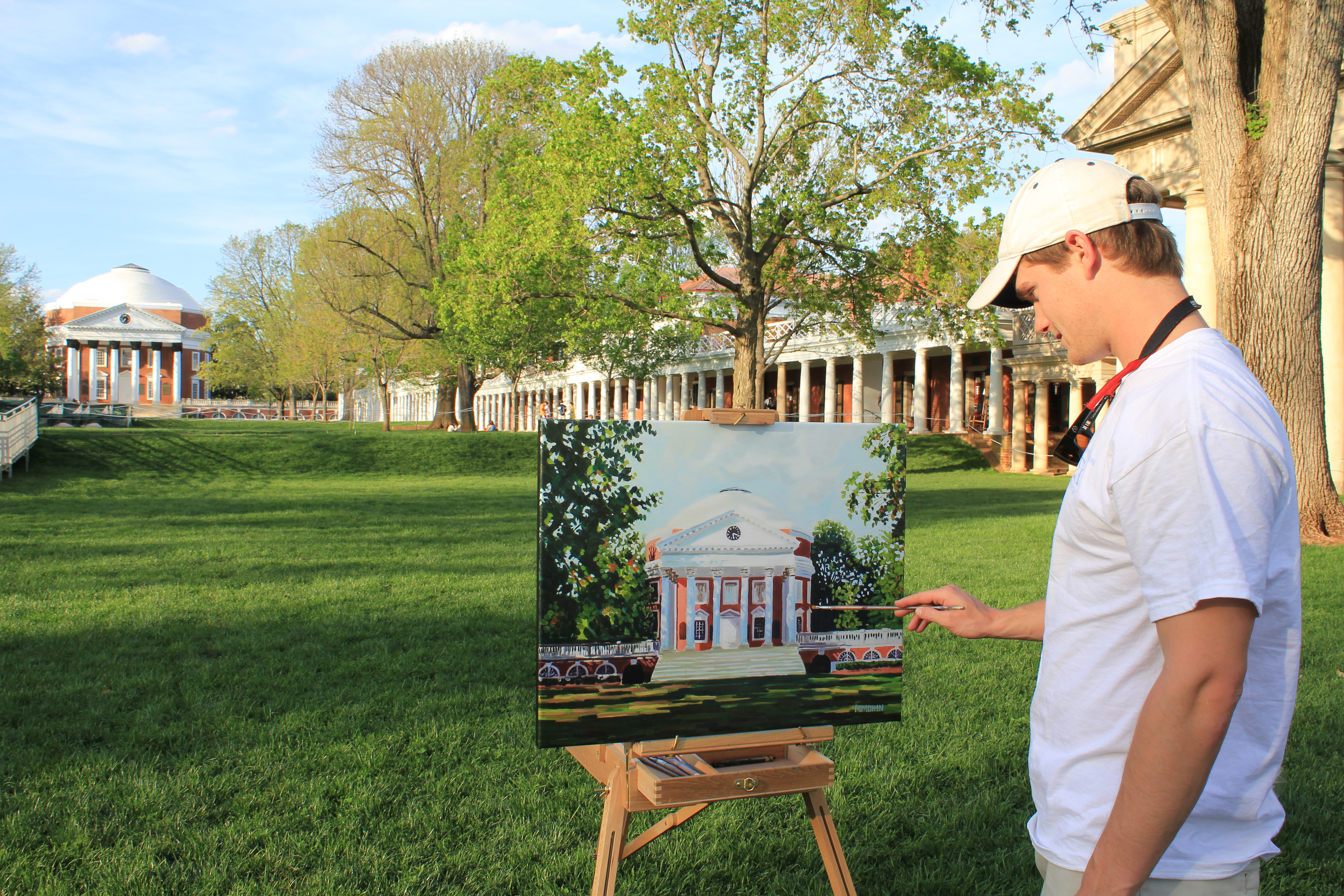May 19, 2011 — How did a portrait of the University of Georgia's mascot serve as the impetus for a soon-to-be University of Virginia graduate's painting of the Rotunda -- and an idea for a business that will be launched this summer?
Miles Morin, who graduates Sunday from the College of Arts & Sciences, explains.
"I took up painting in my second year," he said. Before then, the double-major in economics and religious studies – who also played bass guitar in a funk band called Soiree his first two years on Grounds – had never even picked up a paintbrush. His initial works were "pretty bad," he confessed. But that didn't dampen his artistic aspirations.
Practicing on his own, studying artists' works and taking several painting courses starting in the fall of his third year – first with studio art professor Philip Geiger, followed by independent studies with art professor emeritus Richard Crozier – Morin said he "learned a lot." His painting style now focuses on light and strong contrasts, which in his opinion gives paintings "depth and power."
One of Morin's early professional works was a portrait of the Georgia bulldog mascot, which he painted for a friend. It sparked an idea for an online business; Morin thought that other University of Georgia sports fans might want a print of their beloved bulldog, and that line of reasoning led to painting other schools' mascots and landmarks, including U.Va.'s Rotunda.
Morin's vision for Collegiate Art, a website that he will finish building this summer, started to take shape in his final year as an undergrad, thanks to a McIntire School of Commerce course on entrepreneurship taught by professors Norwood "Trip" Davis III and Eric Martin. Working in teams, Morin and three classmates needed a project for the course. Morin mentioned his idea to the team, and they went to work on designing the business plan.
Morin said Collegiate Art, when finished, will showcase his and other artists' works, which will depict scenes from colleges and universities or other subjects of interest to them. Some of Morin's works on the site will include land- and seascapes and jazz artists, as well as the Georgia bulldog and U.Va.'s Rotunda.
Morin painted the Rotunda in February. He used a photograph of it in mid-summer as a guide because he wanted his painting to show the trees with leaves. While he worked on the project, the actual Rotunda was never far from view, complete with the black netting now shrouding its deteriorating capitals to prevent debris from falling on passersby. "Those black bags are horrible to look at," Morin said.
That's why he decided to donate 20 percent of the proceeds from sales of his Rotunda prints – which do not include the netting – to the Rotunda Restoration Project, a fund established to make necessary and costly repairs to the University's focal point.
"Giving 20 percent may not be a tremendous amount of money, but it will raise awareness about the Rotunda Restoration Project and student giving," Morin said. "And anything I can do to help get rid of those horrible black bags, I will."
Several other things made him want to give back as well. "U.Va.'s been such a formative place for me," he said. "I've learned so much about myself and other people in the world and how to live. … It's an easy place to be grateful to."
Morin said he learned about himself not only in the classroom, but through his involvement with his church here, Christ Episcopal, and through his fraternity, Sigma Chi.
"Learning how to get along with 55 to 75 guys of all temperaments and convictions and having a leadership role there provided me with a huge learning curve, but paid dividends in confidence and assertiveness and a willingness to take initiative," he said.
Morin said he realized this year why he double-majored in economics and religious studies. "It's two ways of looking at why people behave the way they do. One is a rational, mechanical view; the other is more colorful and culturally driven. If you put the two disciplines together, you get a complete look at how individuals think and choose to live their lives."
After graduation, Morin said he will split his time between Charlottesville and his hometown of Virginia Beach, while getting Collegiate Art off the ground. This winter will take him to Panama, where he has been commissioned by the owners of a new hostel there to paint some pieces for them.
After that, it's a blank canvas.
Media Contact
Article Information
May 19, 2011
/content/morin-became-painter-entrepreneur-philanthropist-while-majoring-economics-and-religious

